Apple iPad mini with Retina Display: Reviewed
by Anand Lal Shimpi on November 16, 2013 8:00 AM ESTThe SoC
The iPad mini with Retina Display rounds out the three platforms that use Apple’s A7 SoC. Although both the iPad Air and iPhone 5S use the A7, the mini’s implementation is closer in nature to the iPhone. The iPad mini’s SoC has always used the same package-on-package (PoP) assembly as the iPhone, with DRAM stacked on top of the SoC itself (1GB in this case). The benefit is obviously a reduction in board area, the downsides have to do with cost and thermals. That’s the first similarity between the mini’s A7 and the iPhone’s A7.
The second is one of frequencies. While the iPad Air’s A7 runs its two Cyclone CPU cores at up to 1.4GHz, the SoC in the iPad mini and the iPhone 5S runs at up to 1.3GHz. That might sound like a minor difference, but it’s far more pronounced when you look at what happens to frequency when you’re running heavy workloads.
Once again I turn to a fairly heavy CPU workload to plot performance over time. This is a multithreaded workload, slightly modified from what we used in the iPad Air review, designed to make the CPU cores consume max power. The scale is linear and the workload is the same across all devices, so what you’re effectively looking at is a graph of thermally bound CPU performance over time across all three A7 implementations:
Being the largest device (and the only device with a metal heat spreader and no DRAM stacked on top), the iPad Air obviously maintains the highest frequencies for the duration of the test. The iPhone 5S, with a significant reduction in internal volume (and a PoP SoC) reduces its CPU frequencies early on in order to keep skin temperature down and properly manage thermals. The iPad mini with Retina Display falls between the two, with its performance curve more closely following that of the iPhone 5S.
Although the mini has a similar max operating frequency to the iPhone 5S, it is a faster device thanks to it being less thermally constrained. Similarly, the iPad Air can be much faster than its clock speed would otherwise imply. If you’re wondering why Apple has been so focused on building its own SoCs and CPU architectures, this is the reason why. There’s a fixed amount of power you can dissipate in the form of heat in these mobile devices while still maintaining a good user experience. Performance per watt is the gating metric for success in mobile, and shipping high IPC/low frequency dual-core SoCs at 32/28nm is the best optimization available to a company like Apple today.
As you’d expect, our browser based CPU tests show the mini’s A7 performing in between the iPhone 5S and iPad Air. None of these tests are anywhere near as stressful as our thermal test from above, so we don’t see exaggerated differences in performance between the platforms. For most, I suspect you won’t notice a huge performance difference between the mini and Air. Those who are heavier users (e.g. audio mixing, 3D gaming, etc…), there will be a performance difference between the two iPads.
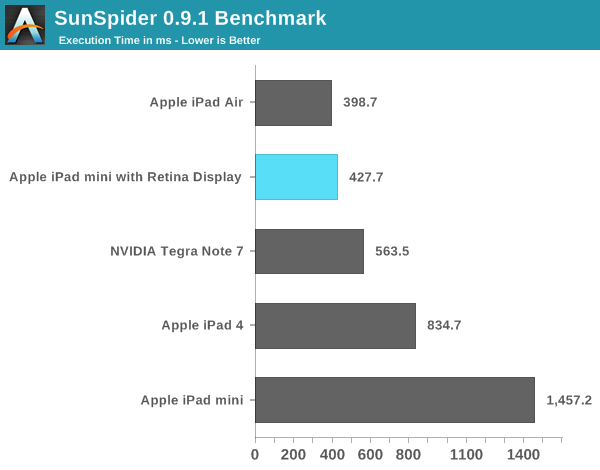

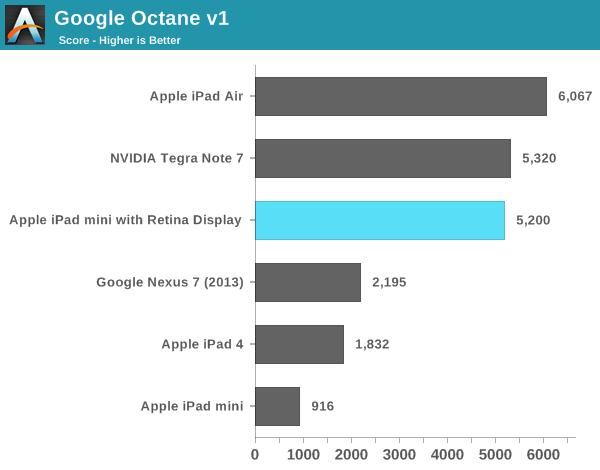
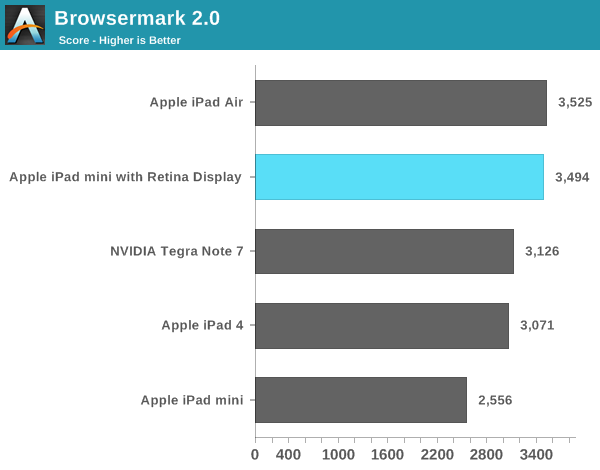
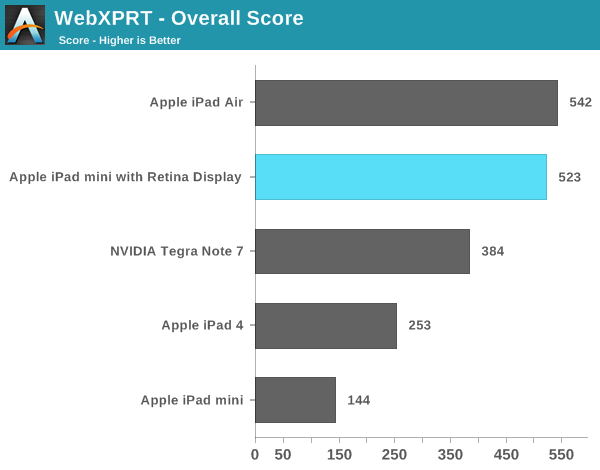
Compared to the first generation iPad mini, the new model is in a completely different performance league. Keep in mind the first mini used Apple’s A5 SoC based on an ARM Cortex A9. That’s the same single threaded performance as what’s in an iPhone 4S, and under iOS 7 it’s clearly running into some performance limits. The new mini with Retina Display however is a completely different animal. It’s fast.
Even comparing to the 4th generation iPad, the new mini is noticeably quicker.
Memory Bandwidth
Looking at the iPad mini’s memory bandwidth curve, we see it tracks very closely with that of the iPhone 5S. This is a slightly modified version of our previous bandwidth test, and you can see peak usable memory bandwidth (from the CPU’s perspective) of around 10GB/s. The ~12GB/s area right before you get out to main memory is bandwidth to the A7’s 4MB system-wide cache that sits after the shared L2 and the memory controller. This cache appears to service CPU, GPU and ISP requests at least.
GPU Performance
I believe the A7’s PowerVR G6430 GPU runs at around 450MHz. This frequency appears unchanged across all three A7 implementations. Once again, the big difference is how much thermal headroom exists in the platform which has an impact on overall performance.
Kishonti’s low level GPU performance tests back up my assertion that GPU frequency is fixed across all A7s. The iPad mini with Retina Display delivers equal performance to the iPad Air. The bigger news here is that nearly all of the GPU bound 3D tests seems to peg the mini and Air as equals. These are some pretty intense tests, but it looks like on the GPU side there’s no significant throttling when running at full tilt.
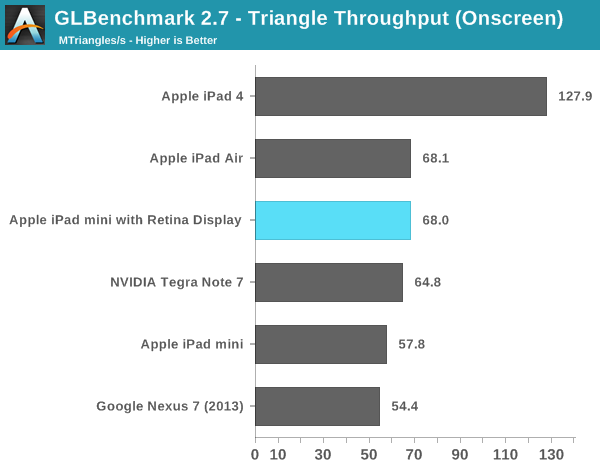

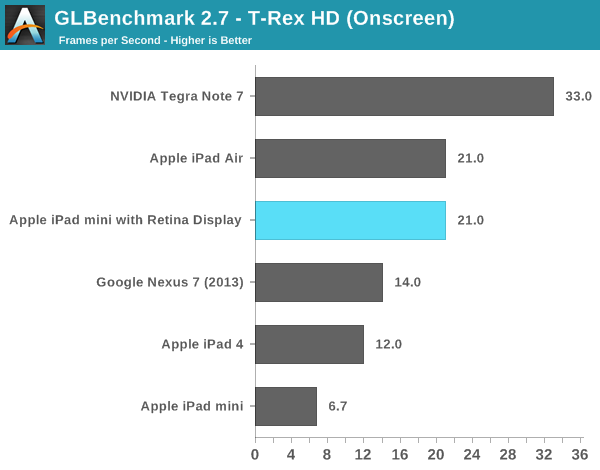

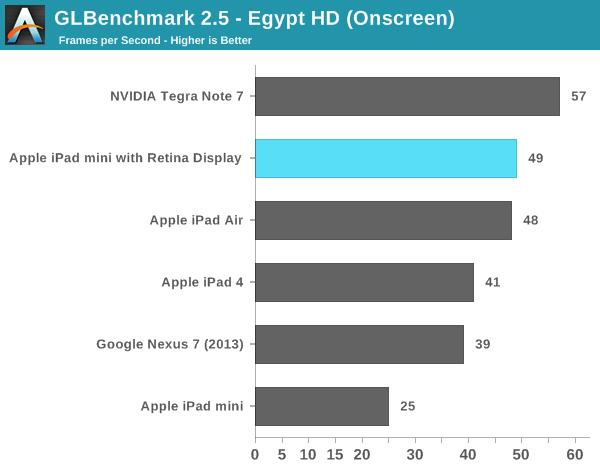
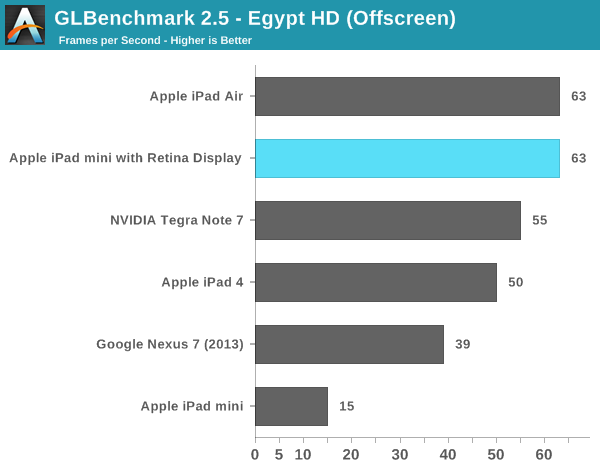
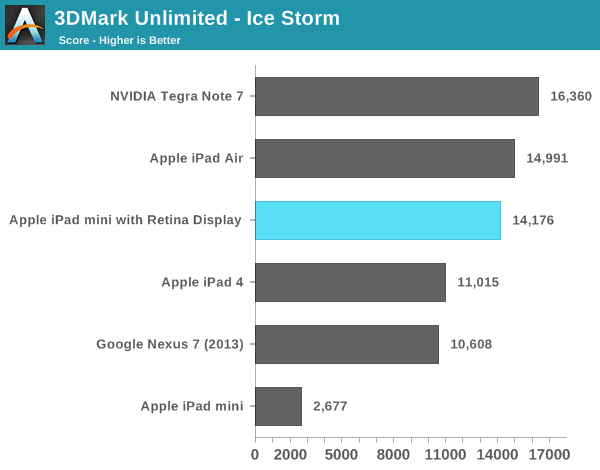
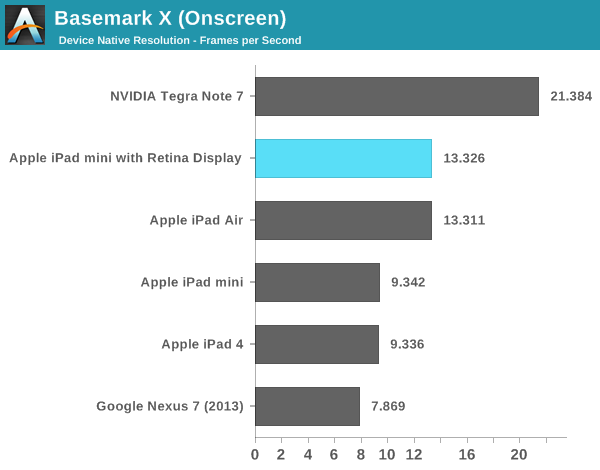
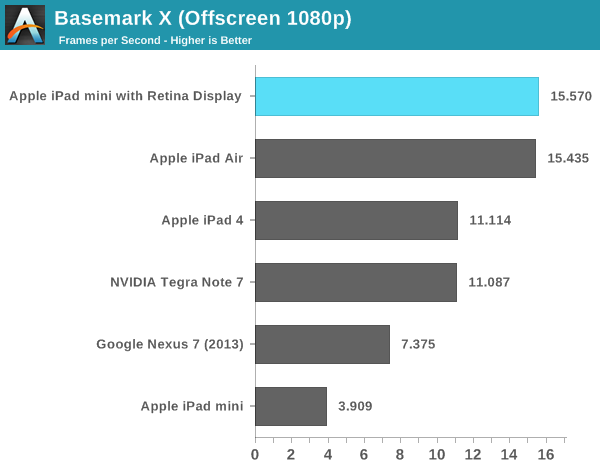
As I mentioned in our iPad Air review, despite having less peak theoretical memory bandwidth than the A5X/A6X, the A7 in the iPad mini never seems to regress in performance compared to even the iPad 4. Across the board the mini appears to be faster, more responsive and have more performance on tap than any prior iPad (big or small). The comparison to the original iPad mini is of course night and day. Even looking at lighter tests like the old GLBench Egypt HD benchmark, the iPad mini with Retina Display manages to be nearly twice as fast as the original mini - all while rendering 4x the number of pixels.


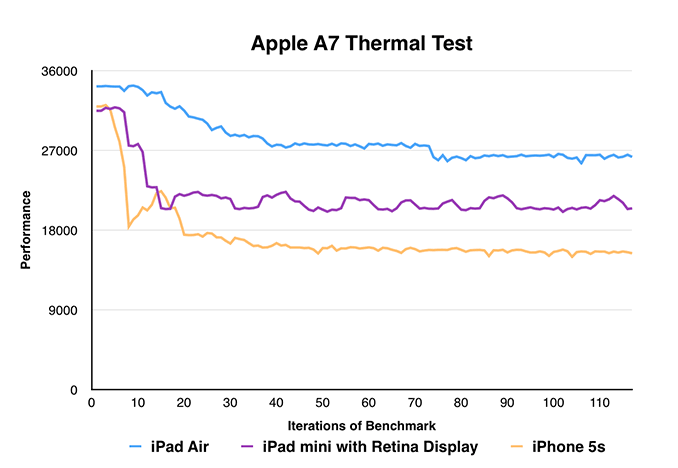
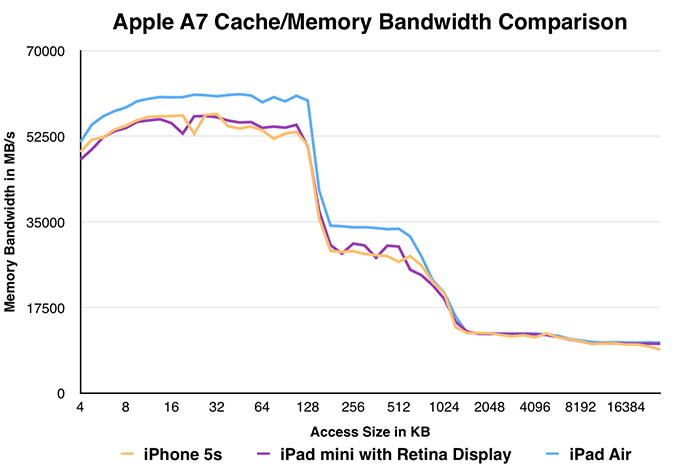








345 Comments
View All Comments
solipsism - Sunday, November 17, 2013 - link
1) Ideal is conception of perfection and everything is a relation to it. For instance, a 0.1 aspect ratio on a 9.7" display would give you a 0.97"x 9.65" display. Is that more or less ideal than 9.7" at 16:9" display for reading?2) Again, there is no obsolete aspect ratio. Simply because something is more commonly used doesn't mean it's not viable. If you think that is a measure of what everyone should be doing then iOS shouldn't be used.
WaltFrench - Saturday, November 16, 2013 - link
Interesting “use case” where you need pro-quality color and fastest-possible processing but are uninterested in the larger screen which more easily lets you see those photos or videos that you're doing all that detail work on.tipoo - Saturday, November 16, 2013 - link
I don't need to do professional work to see the washed out colors.ws3 - Saturday, November 16, 2013 - link
The choice between the retina mini and the air is only "muddier" if you're the kind of ding-dong who buys based on spec sheets.The choice between the air and the retina mini is simple: larger screen vs. lower weight. That's it. If you want a larger screen, you go air. If you want a lower weight, you go mini. Anything else is irrelevant unless you plan to do nothing with your tablet except run benchmarks and display tests.
Puberticus - Saturday, November 16, 2013 - link
Personally, after reading this review I think I'm probably going to get the Air. The weight difference isn't that significant and I think I'm going to appreciate the extra screen area.The size really isn't an issue because I would never consider putting the mini in a pocket in the first place.
moep - Saturday, November 16, 2013 - link
At this rate we’ll see the Haswell rMBP reviews sometime between christmas and new year, yay.Bob Todd - Saturday, November 16, 2013 - link
Yeah, still hoping for a 13" rMBP review soon. And for an insta-ban on all of these asshats filling every Apple article with bias garbage. There are often interesting and insightful comments here from some, too bad I have to get several pages in to find them.allanwood - Saturday, November 16, 2013 - link
Are the LCD and cover glass bonded?Morawka - Saturday, November 16, 2013 - link
This, The air's display gap is very distracting to me, since the display is not laminated, the glass looks like it's a full quarter of a inch away from the display. (i know it's not, but glass bends light and makes it look even worse)They should laminate because it uses less power by having incell touch, and obviously thinner.
Spoony - Saturday, November 16, 2013 - link
The Mini has always had optically bonded glass and LCD, although I'd like to have it confirmed as well. I am looking to get an iPad to read magazines on. However, no buy this generation. If I'm paying this much for a device I want to get a full sRGB display with high accuracy. Which it seems the Mini is not. AND I want an optically bonded display stack, which the Air is not (for some bizarre reason). Sorry, Apple. My standards are very high. Maybe next generation when the 9.7" iPad gets an optically bonded display stack I'll reconsider.